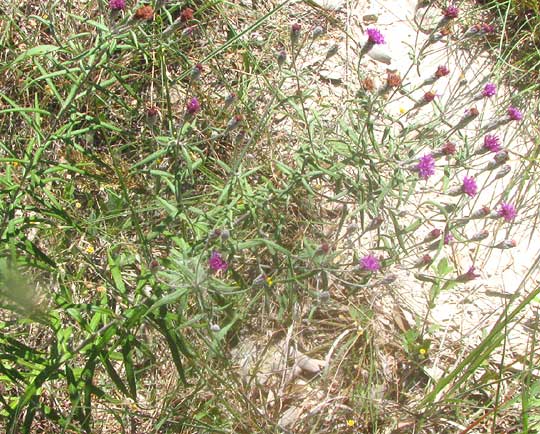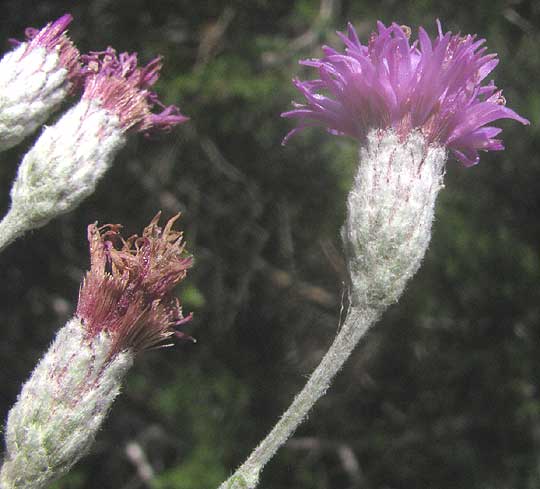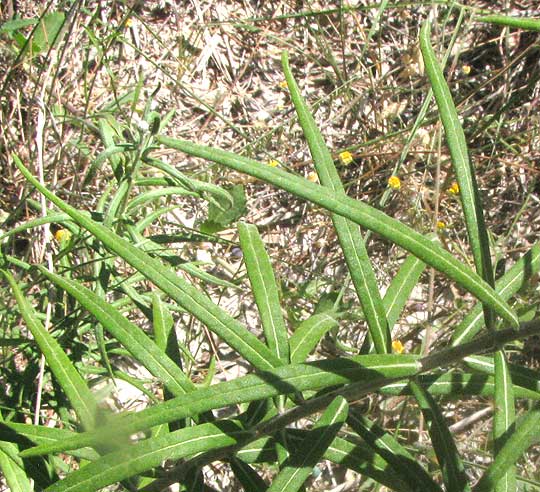Excerpts from Jim Conrad's
Naturalist Newsletter
from the July 21, 2013 Newsletter issued from the Frio Canyon Nature Education Center in the valley of the Dry Frio River in northern Uvalde County, southwestern Texas, on the southern border of the Edwards Plateau; elevation ~1750m (~5750 ft); N29.62°, W99.86°; USA
WOOLLY IRONWEED
In a prairie patch on the floor of the Dry Frio Valley the sun glared, the wind whipped the knee-high grass and mostly lanky, scraggly wildflowers into fast-moving waves, and the heat hammered on head and shoulders. Through eyes burning with sweat a cluster of bean-sized, purplish orbs showed up amidst the swirl of grass and stems, so I wiped the sweat from my eyes and looked closer. The plant body was almost lost in visual clutter of highly animated sun-glints and shadows, but the purplish orbs were something real holding their places there before me, something smiling there in the prairie; in the picture below you can see a frozen moment of what I saw, the purple orbs at the top, right:

Kneeling down I found purple flower heads signaling yet another member of the huge Composite, Daisy or Sunflower Family, one of that subgroup of genera whose flowering heads bear no petal-like ray flowers along their margins, but rather are like cups or goblets holding only cylindrical disc flowers, as you can see below:

Already at this point of "doing the botany," three conspicuous field marks were apparent: the flowers' purplish color; the cottony hairs mantling the cuplike involucre below the flowers, and; the brownish tufts of hair poking from the involucre as seen in the picture's bottom, left corner. The brownish hairs are the pappi atop the cypsela-type fruits; they're the future "parachutes" on wind-disseminated fruits. A longitudinal section of a head better showing the pappi atop their closely packed cypselae within the involucre is seen below:

When I saw what's shown in the last picture I felt sure I knew which genus we had. Notice that at the base of each tuft of purple pappus hairs there's a circle of much shorter hairs or hairy scales forming a crown around the cypsela's top. In other words, in this genus the pappus consists of two distinct kinds of hairs. At the base of each pappus there's a ring of short scales or hairs, then inside the ring there's the usual long hairs that will form the parachute on the mature fruits.
These field marks distinguish the genus Vernonia, among which we find species known as ironweeds, and which are favorite wildflowers throughout much of North America. Some ironweed species are tall, robust plants that in late summer lead the onrush of fall wildflowers with large, pretty inflorescences of purplish flowers -- a purplish hue exactly like that of our prairie species.
Our prairie species is VERNONIA LINDHEIMERI, known as the Woolly Ironweed because of the white-woolly hairs covering their involucres and stems. The Woolly Ironweed is endemic just to central Texas, possibly a corner or Arkansas, and a bit of the contiguous Mexican state of Coahuila. It's described as living on calcareous soils and rocky banks, so our prairie on thin soil atop limestone is a good place for it.
Another good field mark for this herbaceous perennial is its narrow, slender leaves that protrude rather stiffly away from the rodlike stem, as shown below:

Both the narrow, stiff leaves and the woolly hairs are adaptations enabling the Woolly Ironweed to live in habitats drier than other ironweed can, so the Woolly Ironweed is a fine candidate for xeriscaping.